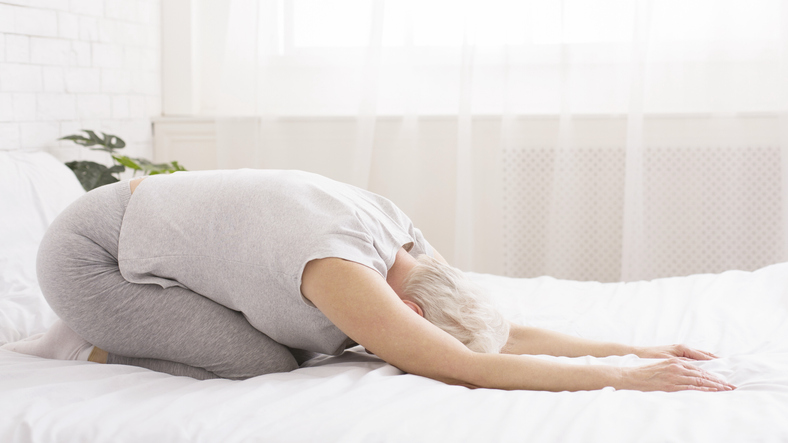Articles, In the Press, Internal Medicine, Mental Health, Resources, Yin, Restorative and Meditation, Yoga Medicine® News
Bedtime Yoga: Expert Tips to Improve Your Sleep Quality
By Brett Larkin for Yoga Medicine®.

The yoga practice has become increasingly popular in recent times. It’s easy to see yoga studios sprawled in different parts of the world. Individuals from all walks of life are having their sessions regularly. However, this practice goes beyond that.
Yoga came from the root word ‘Yuj,’ meaning “to yoke.” It involves a series of stretches and poses combined with breathing exercises. Some known poses include the child’s pose, downward-facing dog, planking, and cobra pose.
The yoga practice involves both the mind and body. That’s why the meditation principles get applied. Brett Larkin, the Founder & CEO of Uplifted Yoga, said that “Its goal is to balance your mind, body, and spirit. The stretching exercises strengthen your body, while the breathing techniques clear your mind. And the whole practice uplifts your spirit.”
That said, yoga comes with a handful of health benefits. Specifically, it helps improve the quality of your sleep. That is why there are yoga techniques designed for slumber.
Let’s look at how you can improve your sleep with bedtime yoga.
The Practical Benefits of Bedtime Yoga
Bedtime yoga involves doing poses, stretches, and breathing techniques before hitting the sack. Its goal is to release the stress in your mind and the tension in your body before bedtime.
But before you earn some expert tips on optimizing your bedtime yoga, let’s delve into its practical benefits:
- Sleep quality: Bedtime yoga primarily aims to improve the quality of your sleep. It can help alleviate your insomnia by helping you sleep faster, longer, and more deeply.
- Stress reduction: It’s easy to get stressed out in life that you want to retreat to your bed at the end of the day. But what if you can’t sleep well? Yoga is a better alternative to pharmaceutical sleep aids. It can reduce your stress from the daily grind and provide you with restful sleep.
- Weight loss: Did you know that weight is associated with sleep? As you sleep better, you’ll manage your weight a lot better. Incorporating bedtime yoga into your lifestyle can boost your sleep and lead to weight loss. Why? You’ll be more mindful of your eating habits.
- Overall well-being: The yoga practice doesn’t only improve your physical body, but it also promotes your mental health. For instance, it can help you relax and reduce your anxiety. You’ll be surprised at how it can foster your overall well-being.
How to Improve Your Sleep with Bedtime Yoga
After tackling the benefits of bedtime yoga, let’s discuss some expert tips on optimizing it. Take the best advice from Larkin:
1. Select the Right Yoga Type for Sleep
Yoga consists of different poses and stretches. Each serves a specific purpose and yields a particular result. As such, choose those that are appropriate for bedtime. If you want to sleep better, consider the yoga tips below:
- Child’s pose: Sink your hips back toward your heels and place your knees close to each other.
- Legs-up-the-wall: It is what it is — your legs up the wall.
- Reclined butterfly: Press your soles together and open your knees to the sides.
- Corpse pose: Lie on your mat as if you’re lifeless.
Consider these poses best suited for sleep. Also, make sure to perform some of these for at least 10 minutes. Finally, don’t forget your breathing exercises.
2. Focus on Breathing
Breathing plays a crucial part in your bedtime yoga. In fact, it helps promote restful and restorative sleep. If you’re wondering how it works, shut your eyes and breathe.
For a meditative experience, don’t allow your mind to wander by focusing on your breath. Do this while you’re in a yoga pose for a few minutes or so. Ultimately, you’ll be surprised at how your breathing can make a difference in your sleep.
3. Prepare Your Bedroom & Make It Conducive for Sleeping
To make the most of your yoga session for sound slumber, you also need to make your bedroom ideal for sleeping.
The Co-Founder & CEO of Kickoff, John Gardner, also integrates yoga sessions in their workout plans, alongside nutrition recommendations.
As some of their clients want to improve the quality of their sleep, they suggest bedroom yoga practice. However, they recommend some crucial steps to make their clients’ bedrooms ideal for slumber. Below are some of these:
- Keep your room clean and tidy.
- Regulate your room temperature.
- Incorporate dim lighting.
- Get rid of gadgets and electronics near the bed.
- Create a relaxing scent in your room with essential oil or candles.
- Play binaural beats or Solfeggio frequencies for music.
At this point, you can go ahead and practice bedtime yoga regularly. However, be sure to consider the valuable recommendations discussed above. By doing so, you’ll reap the benefit of a sound slumber you deserve. Ultimately, you’ll improve the overall quality of your life!












